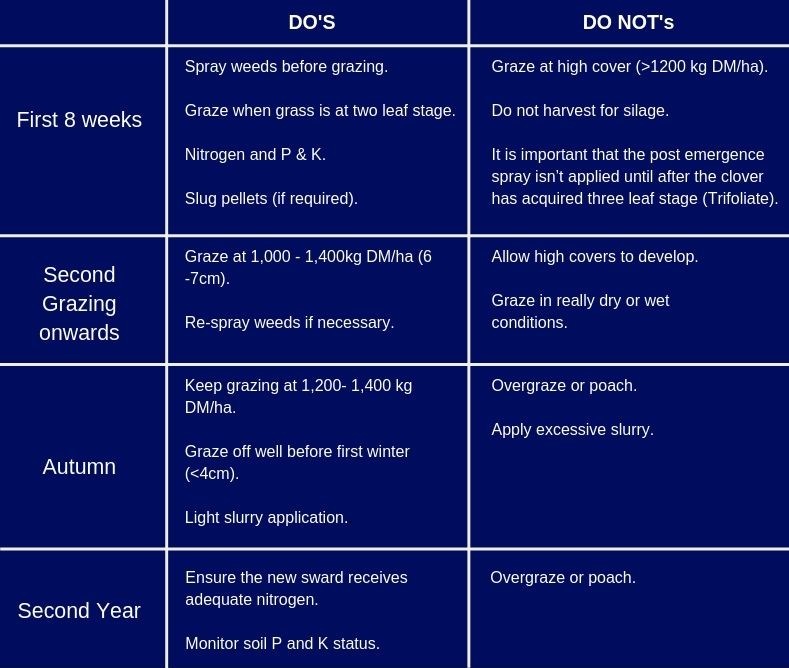It takes approximately 11 months for a new sward to establish; therefore the management of the reseed in this period is crucial to ensure long term productivity of the crop.
Grazing
It is important to graze the new reseed as soon as the plants do not pull out of the ground; approximately 700 – 1000 kg DM/ha. It is especially important that autumn reseeds are grazed before the first winter.
Weed Control
All the benefits of reseeding can be lost after sowing if attention is not paid to weed and pest control.
Weeds in new reseeds are best controlled when the grass is at the 2-3 leaf stage.
Docks and chickweed are the two most critical weeds to control in reseeds but high populations of other weeds such as fat hen, charlock, redshank, mayweed can also cause problems.
- It is essential to control docks and chickweed at the seedling stage. This is achieved by applying a herbicide before the first grazing.
- To achieve the best lifetime control of docks in a sward, eradicating the dock at seedling stage in a reseed is the best opportunity.
- Herbicide choice for dock control will depend on the presence of white clover in the reseed.
Chickweed can be a problem particularly where regular grazing is not expected to take place (silage fields), therefore herbicide choice is important. You should consult your local distributor or adviser for advice on the correct herbicide, remembering to keep the prescribed cross-compliance records and follow the instructions on the product label. Pesticide users must comply with the regulations as outlined in the Sustainable Use Directive (SUD).
Pest Control
The three most significant pests of reseeds are Frit Fly, Leatherjackets and Slugs
Frit Fly
Frit Fly is most prevalent in autumn after a dry summer, and in reseeded swards with high levels of debris (minimum cultivation), however reseeding carried out by direct drilling is also at risk. Evidence of Frit Fly can be seen when the centre shoot turns yellow and at this stage the plant dies away. New grass sown after grass or grassy cereal ground is most at risk.
Control of Frit Fly is achieved by spraying an insecticide if 10% or more of shoots if plants are damaged. (Walk diagonally across the field and tug 100 central shoots of new plants. If 10% of shoots pull away easily apply an insecticide). If possible, leave ground unsown for 6+ weeks after ploughing.
Leatherjacket
Leatherjacket is most active in wetter/heavier soils. Leatherjacket damage is characterised by dead plants on the soil surface. Control is achieved by application of an insecticide.
Slug
A slug attack is most prevalent during wet weather or where fields tend to be damp, such as headland areas. Having high levels of trash in the seedbed will also increase the likelihood of slug attack.
The most common evidence of slug attack is shredded leaves; more prevalent where reseeding is carried out by direct drilling. This method creates slits in the ground which act as a protective shelter for slugs. The likelihood of damage to the new grass plants can be greatly reduced by ensuring a firm seedbed by rolling. Most of the major slug species cannot burrow into the soil.
Slug pellets can be applied to control the problem. Usually applying slug pellets to the margins of fields/paddocks is adequate. Higher seeding rates should be considered where reseeding is carried out by direct drilling to counteract slug attack.
More Information
For further advice on weed or pest control, contact your local distributor.
To read more about our grass seed mixtures, click here or download our Agritech Grass Seed Brochure (2MB).


